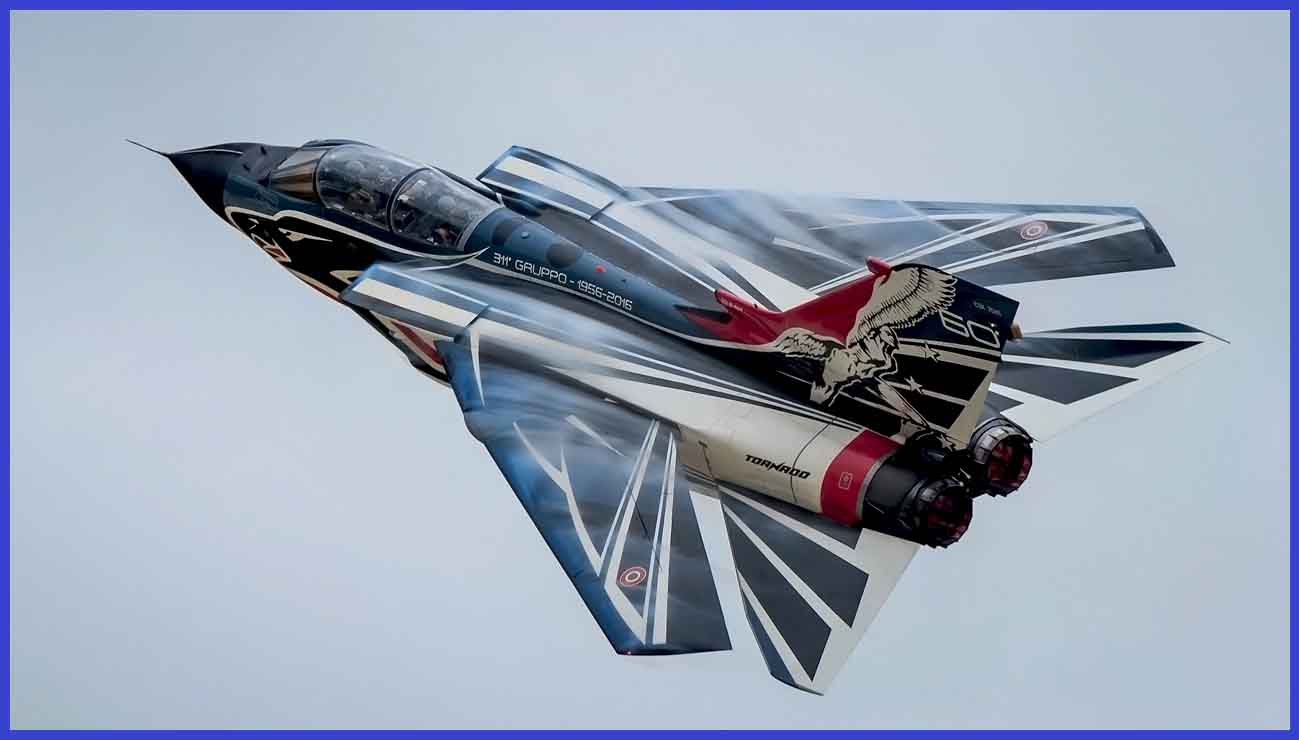
The aircraft had its maiden flight on August 14, 1974, and entered active service between 1979 and 1980. Its remarkable multirole design enables it to seamlessly transition between various flight profiles, ranging from high-speed supersonic missions to slower, low-level attacks. This adaptability has made the Tornado a standout in the field, with the ability to excel in roles encompassing air superiority, ground attack, electronic warfare, reconnaissance, and maritime strike. Notably, it efficiently replaced numerous aircraft fleets within the adopting air forces. According to reports, a total of 990 aircraft were built, including all variants, from 1979 to 1998.
Designed to be armed with a diverse array of precision-guided munitions, the Panavia Tornado Aircraft possesses the capability to strike ground targets with exceptional precision. Its advanced avionics systems and all-weather capabilities establish it as a formidable asset in contemporary air warfare. The Tornado has played pivotal roles in various conflicts, including the Gulf War, the Bosnian War, the Kosovo War, the Iraq War, and Libya during the 2011 Libyan civil war, as well as contributing to smaller operations in Afghanistan, Yemen, and Syria.
While the British Royal Air Force retired the fighter in 2019, the Tornado continues to serve in three countries, namely the German, Italian, and Saudi Air Forces, as of 2023. It is worth noting that more modern aircraft have largely replaced it in recent years.
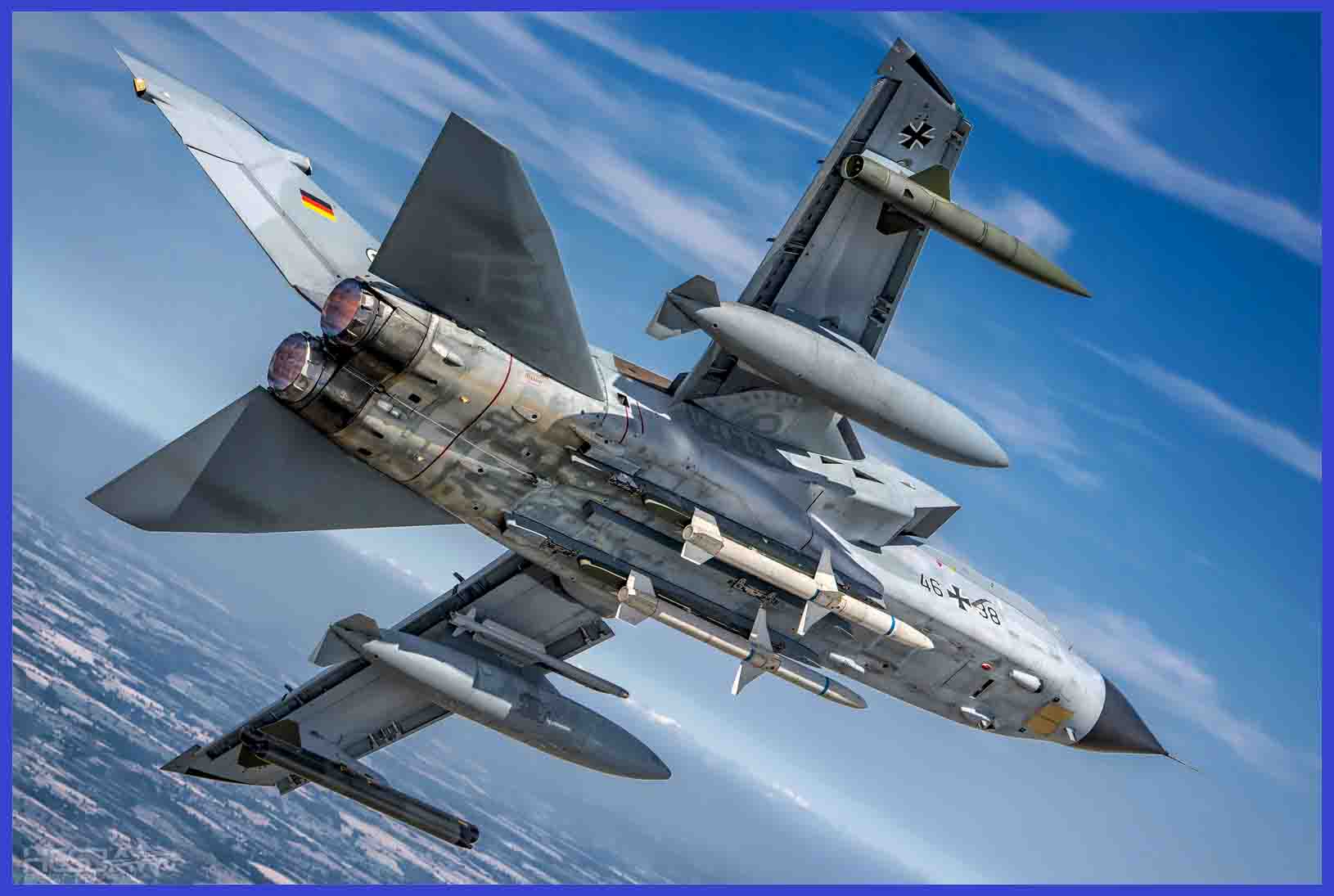
The development story of the Panavia Tornado was a collaborative effort that brought together three European nations to create a highly capable multi-role combat aircraft.
Consortium Formation: In the late 1960s, the field of aeronautical design witnessed a growing interest in variable-geometry wing concepts, aiming to combine the agility and efficient cruising associated with straight wings and the high-speed capabilities of swept wing designs. This led to the formation of a collaborative effort in 1968, comprising West Germany, the Netherlands, Belgium, Italy, and Canada, collectively referred to as the Multi-Role Combat Aircraft (MRCA) working group.
Their primary objective was to investigate potential replacements for the ageing Lockheed F-104 Starfighter and Blackburn Buccaneer strike aircraft. Given the diverse requirements of the participating nations, a decision was made to embark on the development of a single aircraft capable of fulfilling a wide range of mission profiles, effectively consolidating the roles previously carried out by various aircraft. The United Kingdom subsequently joined the MRCA group in 1968.

Canada, the Netherlands, and Belgium withdrew from the program in 1969 before making any substantial, long-term commitments. However, the United Kingdom, West Germany, and Italy remained steadfast in their commitment to developing a modern, variable-sweep wing combat aircraft, recognizing the necessity of replacing their existing fleets. This shared recognition led to their decision to collaborate and collectively address their common requirements.
In 1970, these three nations established the Panavia Aircraft GmbH consortium. The name “Panavia” was coined from “Pan-European.” This collaborative consortium enabled them to combine their resources, expertise, and technology, resulting in the creation of a more cost-effective and capable aircraft.

Prototypes to Production: The inaugural prototype of the Tornado, referred to as “P.01,” successfully took its first flight in August 1974 over Manching, Germany. Following this milestone, a comprehensive phase of testing and refinement ensued, leading to the construction of a pre-production series designed to confirm the design’s functionality and operational capabilities. Regrettably, during the testing phase, three prototypes met with accidents, largely attributed to poor piloting decisions and errors, resulting in two ground collision incidents.
Each consortium member, including the United Kingdom, West Germany, and Italy, had its own manufacturing facilities and specific responsibilities for producing distinct components of the Tornado. The maiden flight of a production aircraft occurred in July 1979 at BAe Warton. Subsequently, the first batch of aircraft was delivered to the Royal Air Force (RAF) and the German Air Force on June 5 and 6, 1979, respectively.
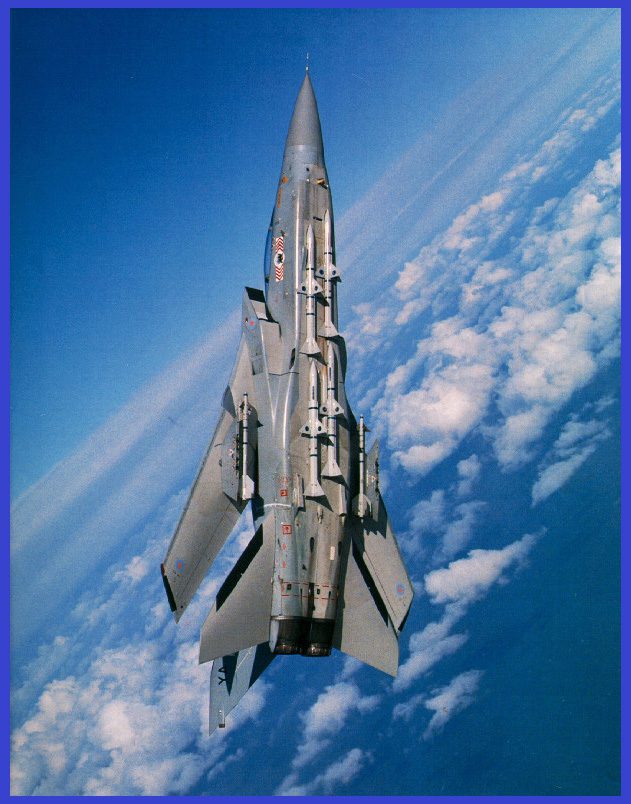
The first Italian Tornado was delivered in September 1981. In January 1981, the Tri-National Tornado Training Establishment (TTTE) was officially inaugurated at RAF Cottesmore and remained active in training pilots from all participating nations until March 31, 1999.
Saudi Arabia stood as the sole export customer of the Tornado aircraft. The procurement of the Tornado was a component of the Al-Yamamah arms deal forged between British Aerospace and the Saudi government. The production phase concluded in 1998, with the final set of aircraft delivered to the Royal Saudi Air Force, which had placed an order for a total of 96 IDS Tornados.
In total, 990 Tornado aircraft were manufactured, coming close to the rounded figure of 1,000. In June 2011, it was publicly disclosed that the Tornado fleet had collectively logged over one million flying hours.

With its distinctive variable-sweep wing design, the Panavia Tornado stands out as a surprisingly adaptable multi-role combat aircraft. This flexible wing design is essential for reducing drag while making low-level approaches against prepared opponents. The Tornado’s design includes a plethora of features and abilities that are intended to be used to complete a wide variety of mission types. A brief description of the Tornado’s design can be found below:
Variable-Sweep Wing: One of the most distinctive design features of the Panavia Tornado is its variable-sweep wing, which can be adjusted during flight. This design feature enables the aircraft to optimize its performance for a wide range of mission types, including high-speed supersonic flight and slower, low-level attack missions. The variable wing can be adjusted either automatically or manually by the pilot, allowing for the maximization of aerodynamic efficiency and control at different speeds. The wing’s variable-sweep capability allows it to assume sweep angles between 25 degrees and 67 degrees, with an associated speed range for each angle.
In certain Tornado ADV variants, an automatic wing-sweep system was integrated to reduce the pilot’s workload. When the wings are swept back, they decrease the exposed wing area, resulting in a significant reduction in drag. This configuration is particularly advantageous for achieving high-speed, low-level flight. Additionally, the weapons pylons are designed to pivot in alignment with the variable-sweep wing angles, ensuring that the stores remain oriented in the direction of flight, without impeding any wing positions.
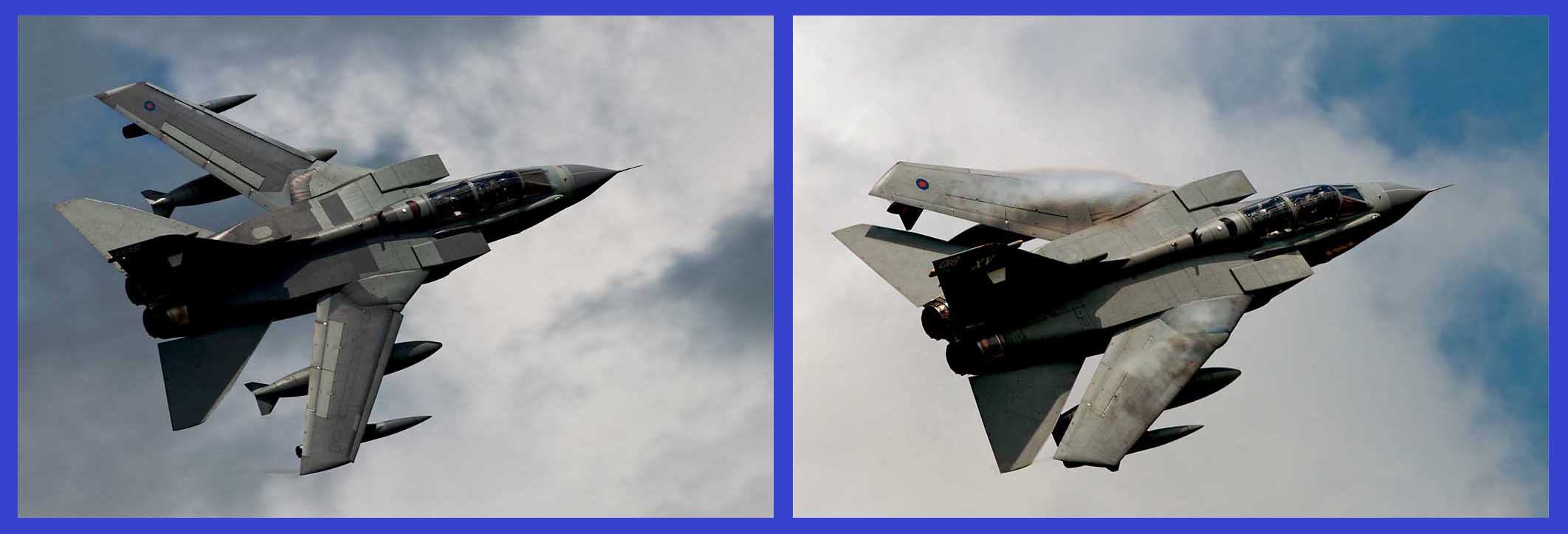
Cockpit: The cockpit is designed for a two-member crew, with the pilot and navigator/weapons officer sitting in a tandem configuration. This layout facilitates effective communication and mission coordination. The cockpit is equipped with a wide range of advanced avionics, including a Heads-Up Display (HUD) and multi-function Displays (MFDs) for efficient management of the aircraft and its systems.
The Tornado’s primary flying controls comprise a fly-by-wire hybrid system consisting of a digital Autopilot and Flying Director System (AFDS) connected to an analogue quadruplex Command and Stability Augmentation System (CSAS). To ensure resilience against potential failures, a certain level of mechanical reversal capability was also retained. Artificial feedback was integrated into the flight controls, including the centrally located stick, to enhance pilot awareness.
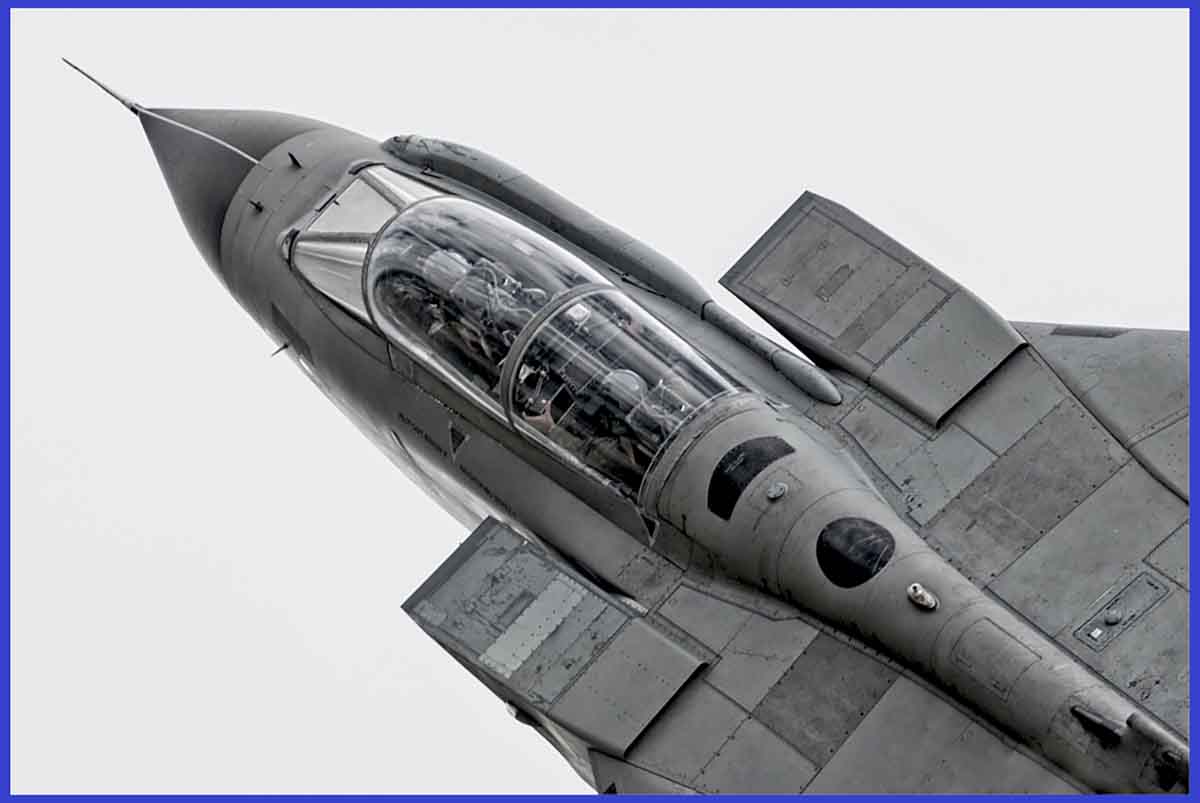
These artificial responses automatically adapt to changes in wing profile and other variations in flight attitude due to the Tornado’s flexible wings, which enable significant shifts in its flight envelope. The flight stability system routinely compensates for the resulting adjustments to the aircraft’s flight dynamics, as it can be equipped with a wide range of munitions and stores.
During low-level flight operations, the Tornado’s integrated navigation/attack Doppler radar simultaneously searches for targets and executes fully automatic terrain-following. One of the Tornado’s key advantages is its capability to fly hands-free at low altitudes in all weather conditions.
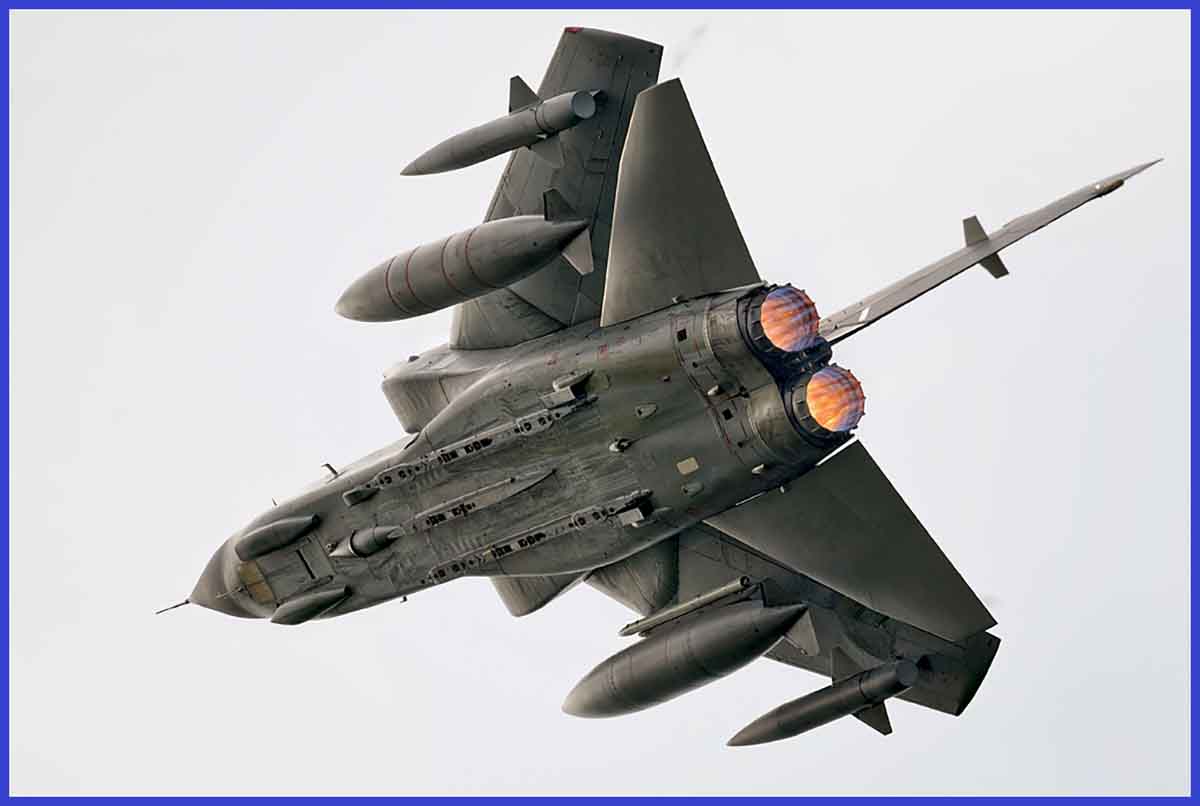
Engines: The Tornado is equipped with two turbofan engines, typically the Turbo-Union RB199. These engines deliver remarkable thrust and performance capabilities, enabling the aircraft to fulfil a variety of mission profiles. In 1974, the first prototype Tornado powered by the RB199 engines completed its maiden flight, and by late 1978, the engine successfully passed its qualification tests. The final production-standard engine met stringent criteria for both reliability and performance. To operate efficiently across a broad spectrum of conditions and speeds, including speeds up to Mach 2, the RB199 employs variable intake ramps to control the airflow.
The aircraft’s engines are equipped with thrust reversers to facilitate precise landings. It’s relatively uncommon for fighter aircraft to be fitted with thrust reversers, but the RB199 engine incorporates this feature to reduce the required landing distance. To enable the full deployment of the thrust reverser during landings, the yaw damper is linked to the steering of the nosewheel, enhancing overall stability.
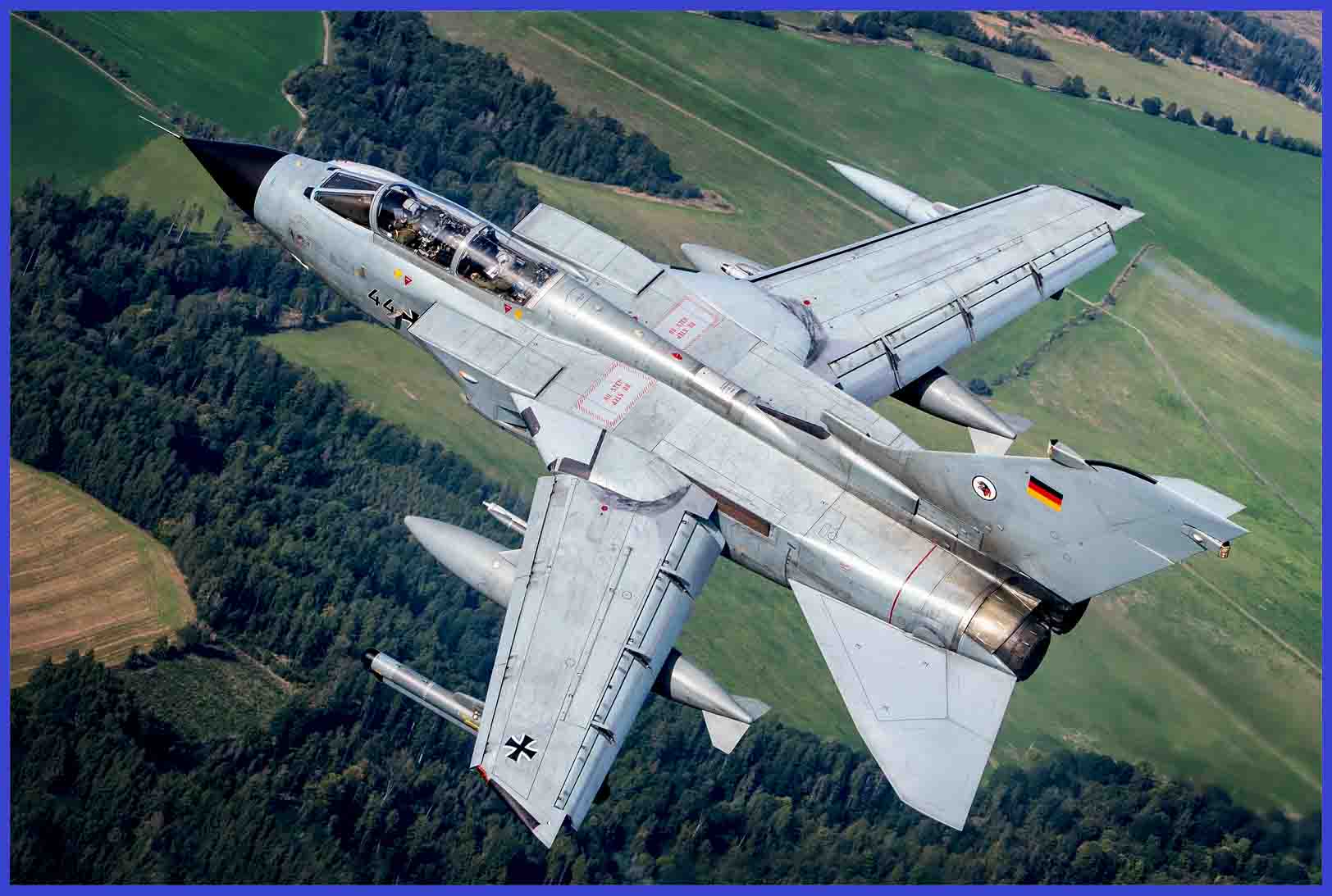
Armament and Payload: The Tornado’s design incorporates numerous hardpoints and weapon stations, providing the capacity to transport a diverse array of munitions, both air-to-air and air-to-ground. This includes an assortment of unguided and laser-guided bombs, anti-ship and anti-radiation missiles, as well as specialized ordnance like anti-personnel mines and anti-runway munitions, among others. For self-defence and air superiority missions, the aircraft can be equipped with a combination of short-range and medium-range air-to-air missiles.
Following upgrades, the Tornado has been adapted to deploy a range of new armaments, including Enhanced Paveway and Joint Direct Attack Munition bombs, as well as modern cruise missiles like the Taurus and Storm Shadow missiles. While the Strike variants possess a limited air-to-air capability with AIM-9 Sidewinder or AIM-132 ASRAAM air-to-air missiles (AAMs), the Tornado Air Defence Variant (ADV) is equipped with beyond visual range AAMs, such as the Skyflash and AIM-120 AMRAAM missiles. Additionally, the Tornado is armed with 27 mm Mauser BK-27 revolver cannons, which are internally mounted underneath the starboard side of the fuselage.

The Tornado is equipped to carry air-launched nuclear weapons. As of now, German and Italian Tornados have the capability to deliver US-origin B61 nuclear bombs, which are made accessible through NATO. In total, it is capable of carrying a payload with a capacity of 9,000 kg (19,800 lb) of munitions.
Survivability and Defensive Systems: The aircraft’s design incorporates defensive countermeasures to shield against various threats, including radar-guided and heat-seeking missiles. To enhance its survivability in combat situations, the Tornado is equipped with an array of onboard countermeasures. These countermeasures encompass flare and chaff dispensers, as well as electronic countermeasure pods that can be affixed underneath the wings. For extended range capabilities, underwing fuel tanks and a buddy store aerial refuelling system are also available, allowing one Tornado to refuel another.
Tornado IDS (Interdictor/Strike): GR1, GR1B, GR1P, GR4, GR1A/GR4A
This variant serves as the Tornado’s primary ground-attack and strike version, specifically designed for low-level interdiction and ground-attack missions. It boasts the capability to carry an assortment of air-to-ground munitions, which includes precision-guided weapons. Subsequent modifications have led to the designations Tornado GR1A, Tornado GR1B, Tornado GR4, and Tornado GR4A. The Tornado GR1B represents a specialized anti-shipping variant derived from the GR1, effectively replacing the Blackburn Buccaneer attack aircraft.
The GR1 Mid-Life Update (MLU) initiative commenced in 1984 and received approval in 1994, resulting in the development of the GR4 standard. British Aerospace (later BAE Systems) undertook the upgrade of 142 Tornado GR1s to GR4 standard, starting in 1996 and completing the process in 2003. The GR1A variant serves as the reconnaissance version utilized by the RAF and RSAF, equipped with the TIRRS (Tornado Infra-Red Reconnaissance System). As the Tornado GR1s were upgraded to GR4 configuration, the GR1A aircraft also underwent upgrades to become GR4A standard.
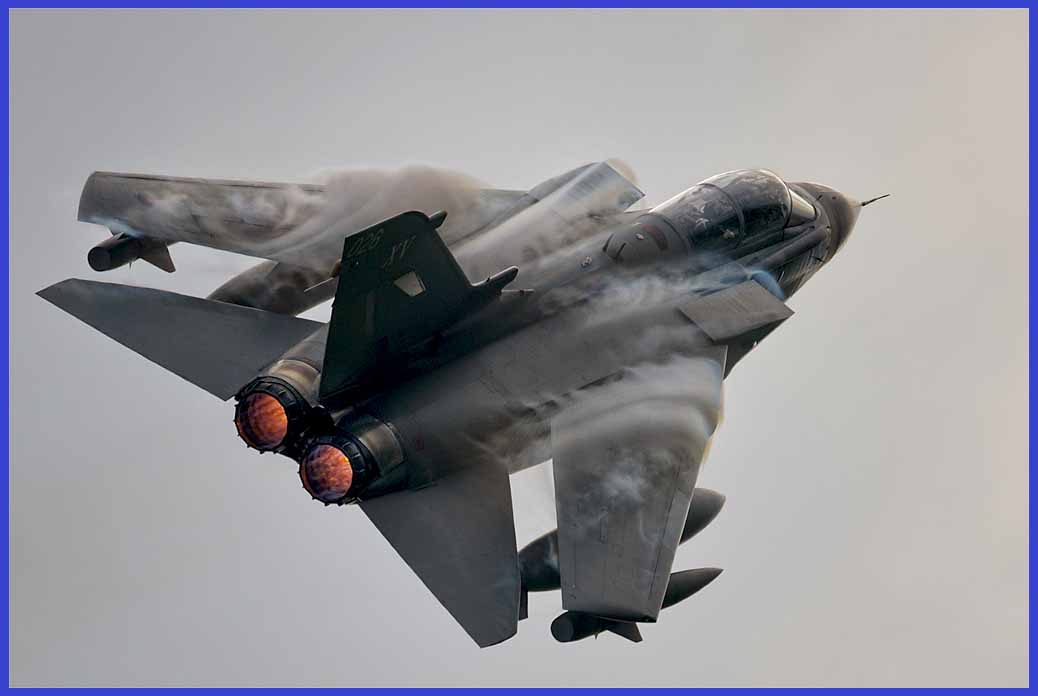
Tornado IDS (RSR, Reconnaissance and Strike Reconnaissance)
Some Tornados were modified for the dedicated reconnaissance and strike reconnaissance roles. These aircraft were equipped with cameras and sensors for intelligence-gathering missions.
Tornado ADV (Air Defence Variant)
This particular variant was tailored for air defence and air superiority roles, incorporating advanced radar and avionics systems to effectively intercept enemy aircraft. The ADV variant was primarily operated by the Royal Air Force (RAF) and the Italian Air Force, with its main objective being the interception of Soviet bombers crossing the North Sea to prevent potential air-launched nuclear attacks on the United Kingdom.
For this purpose, it was equipped with a potent radar and beyond-visual-range missiles. Development of the ADV variant, based on the multinational Tornado IDS, proceeded relatively swiftly. Originally, the program was initiated solely by the United Kingdom, and the first prototype completed its maiden flight in October 1979.
The Royal Air Force (RAF) introduced the Export model Tornado F2 in 1986, but in limited quantities due to essential equipment deficiencies, notably radar, owing to development challenges. Subsequently, the Italian Air Force (AMI) and the Royal Saudi Air Force (RSAF) adopted the Tornado F-3 as the RAF’s primary model. Throughout its operational life, the Tornado ADV underwent multiple modification programs that bolstered its aerial capabilities, enabling it to carry out the Suppression of Enemy Air Defenses (SEAD) mission and its interceptor duties.
However, in the early 2010s, all three air forces gradually phased out their Tornado ADV fleets due to its limited agility and the introduction of newer fighters, with the type being succeeded by the Eurofighter Typhoon.
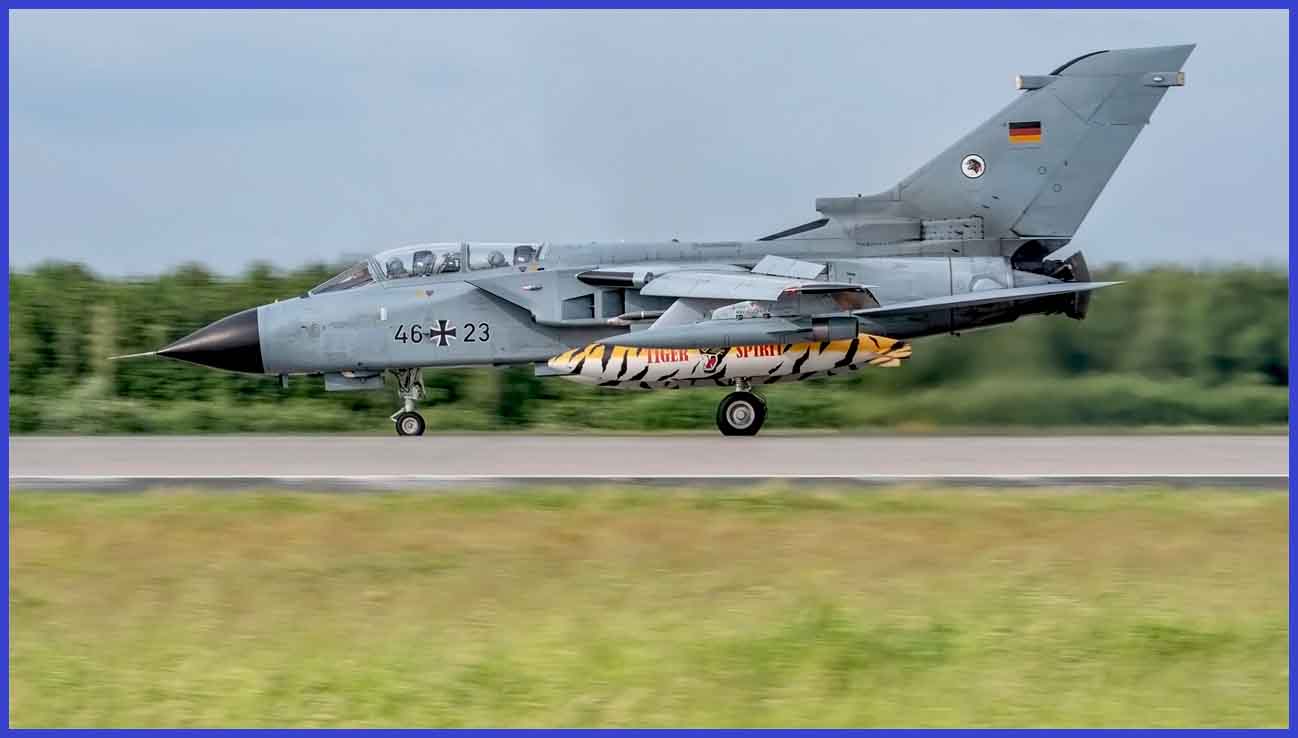
Tornado ECR (Electronic Combat/Reconnaissance)
The Tornado ECR was developed for electronic warfare and reconnaissance missions, being equipped with specialized electronic countermeasures for the suppression of enemy air defences. This variant primarily served with the German Air Force, with the first delivery occurring on May 21, 1990.
The ECR is armed with anti-radiation AGM-88 HARM missiles and features sensors designed to detect radar emissions. Italy acquired 16 converted IDSs for their ECR fleet, while the Luftwaffe received 35 brand-new ECRs. Notably, Italian Tornado ECRs differ from Luftwaffe aircraft in that they utilize RecceLite reconnaissance pods instead of built-in reconnaissance capabilities. The RB199 Mk.105 engine, boasting a higher thrust rating, is exclusively featured in Luftwaffe ECRs.
As of now, the estimated number of Tornado Aircraft, based on sources, is as follows: By December 2018, the German Air Force had 94 IDS and 28 ECR aircraft in service. The Italian Air Force maintained 70 A-200 and 5 EA-200 aircraft, and the Royal Saudi Air Force had 81 IDS aircraft in service. In contrast, the UK’s Royal Air Force had already retired both variants of Tornados (IDS and ADV) by 2019.

This fighter boasts a rich operational history. The Tornado was introduced into the fleets of the original consortium members, the United Kingdom, West Germany, and Italy, during the late 1970s and early 1980s. Primarily designed as a Cold War aircraft for use in NATO across various roles, the Tornado played a significant role during the Gulf War, known as Operation Desert Storm. It was employed for both air-to-air combat and precision ground attacks. Tornados conducted deep-strike missions, utilizing laser-guided bombs and other precision munitions to target key Iraqi installations.
Tornados were deployed in various NATO operations during the Balkans conflict, including the enforcement of no-fly zones and participation in air-to-ground attacks in Bosnia and Kosovo. They were once more widely utilized in the 2003 invasion of Iraq, conducting air-to-ground operations targeting infrastructure and military installations. In 2011, they were involved in enforcing a no-fly zone and conducting airstrikes against Libyan government forces during the Libyan Civil War. Additionally, they were extensively used in Afghanistan after 9/11 to deter Taliban attacks.

- Crew: 2
- Length: 54 ft 10 in ( 16.72 m )
- Wingspan: 45 ft 8 in ( 13.91 m ) @ 25° sweep
- Swept wingspan: 28 ft 3 in ( 8.60 m ) @ 67° sweep
- Height: 19 ft 6 in ( 5.95 m )
- Wing area: 26.6 m2 (286 sq ft)
- Empty Weight: 13,890 kg ( 30,622 lb )
- Max Takeoff Weight: 20,240 kg ( 44,622 lb )
- Max Weapons Payload: 9,000 kg ( 19,800 lb )
- Powerplant: 2 × Turbo-Union RB199-34R Mk 103 afterburning 3-spool turbofan, 43.8 kN (9,800 lbf) thrust each dry, 76.8 kN (17,300 lbf) with afterburner
- Max Speed: Mach 2.2 / 2,400 km/h ( 1,500 mph ) and 1,482 km/h (921 mph ) Sea level
- Combat range: 1,390 km ( 860 mi, 750 nmi )
- Ferry range with two fuel tanks: 3,890 km ( 2,420 mi, 2,100 nmi )
- Service ceiling: 50,000 ft ( 15,240 m )
- Rate of climb: 77 m/s
- Armament: One 27 mm Mauser BK-27 revolver cannon is internally mounted under the starboard side of the fuselage. The aircraft features a total of 7 hardpoints, comprising 4 under-wing and 3 under-fuselage pylon stations. These hardpoints have the capability to carry a payload exceeding 9,000 kg (19,800 lb) for multi-role configurations. The available combinations encompass a variety of weapons, including Sidewinder, AMRAAM, and ASRAAM air-to-air missiles, as well as Brimstone, Storm Shadow, and ALARM air-to-surface missiles, along with Paveway and B61 tactical bombs.
In conjunction with this article, take advantage of the exclusive opportunity to acquire a premium 1/72 scale diecast model of a Panavia Tornado IDS, a multirole combat fighter. These extraordinary and renowned military aircraft, celebrated as the pinnacle of advanced and sophisticated fighter planes, are currently available for purchase through AirModels, with global delivery options. Act promptly to secure these exceptional models before the limited stock is depleted.

In Conclusion, the Panavia Tornado, a product of international cooperation, has played a pivotal role in modern military aviation. Its adaptability for air defence, ground attack, and electronic warfare made it a versatile asset. Over the years, it served in notable conflicts, including the Gulf War and the Balkans conflict, showcasing its effectiveness in varied missions. While its numbers have dwindled in recent years, the Tornado’s legacy as a capable multi-role combat aircraft continues to influence the landscape of military aviation. It remains a testament to the successful collaboration and innovation within the aerospace industry, leaving an indelible mark on history.
Important Announcement for Our Valued Readers!
After an article is published, it is possible that updates or changes may have occurred beyond the time of publication. Therefore, it is important to be aware that certain information in the article might be outdated. To ensure the most accurate analysis, it is highly recommended to verify the content with the latest sources available.
However, we are dedicated to delivering outstanding articles on military products and global updates. Maintaining quality and smooth operation requires resources. Your support sustains our efforts in providing insightful content. By purchasing high-quality products through our affiliated links, you help us keep our platform alive and acquire top-notch items. Your unwavering support is invaluable and inspires us to strive further.
We welcome your suggestions and requests for more information, as we value feedback from our readers. If there’s specific defence material or equipment not covered on our site, please share your request in the comments. We’ll strive to research and provide the required information. We sincerely thank you for your unwavering interest in our website, and we eagerly anticipate hearing from you! Enjoy your reading experience!
